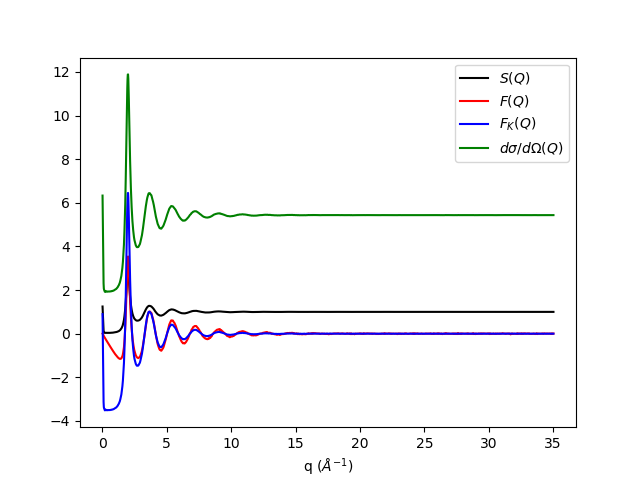\(\renewcommand\AA{\unicode{x212B}}\)
Table of Contents
| Name | Direction | Type | Default | Description |
|---|---|---|---|---|
| InputWorkspace | Input | MatrixWorkspace | Mandatory | Input workspace with units of momentum transfer |
| From | Input | string | S(Q) | Function type in the input workspace. Allowed values: [‘S(Q)’, ‘F(Q)’, ‘FK(Q)’, ‘DCS(Q)’] |
| To | Input | string | S(Q) | Function type in the output workspace. Allowed values: [‘S(Q)’, ‘F(Q)’, ‘FK(Q)’, ‘DCS(Q)’] |
| OutputWorkspace | Output | Workspace | Mandatory | Output workspace |
The neutron diffraction is measuring the differential scattering cross section (DCS(Q) in the algorithm)
Here the \(N\) is the number of scattered neutrons in unit time in a solid angle \(d\Omega\), and \(\phi\) is the incident neutron flux. The algorithm supports the following conversions:
where \(N_s\) is the number of scatters in the sample and both \(\langle b_{tot}^2 \rangle\) and \(\langle b_{coh} \rangle^2\) are defined in the Materials concept page.
NOTE: This algorithm requires that SetSampleMaterial v1 is called prior in order to determine the \(\langle b_{tot}^2 \rangle\) and \(\langle b_{coh} \rangle^2\) terms.
This algorithm uses the external project PyStoG and specifically uses the pystog.converter.Converter object. To modify the underlying algorithms, the following functions are used for the conversions.
pystog.converter.Converter.DCS_to_F()pystog.converter.Converter.DCS_to_FK()pystog.converter.Converter.DCS_to_S()pystog.converter.Converter.S_to_F()pystog.converter.Converter.S_to_FK()pystog.converter.Converter.S_to_DCS()pystog.converter.Converter.F_to_DCS()pystog.converter.Converter.F_to_FK()pystog.converter.Converter.F_to_S()pystog.converter.Converter.FK_to_DCS()pystog.converter.Converter.FK_to_F()pystog.converter.Converter.FK_to_S()import wget
import numpy as np
import matplotlib.pyplot as plt
from mantid.simpleapi import CreateWorkspace, SetSampleMaterial, PDConvertReciprocalSpace
from mantid import plots
# Grab the reciprocal data for argon
url = "https://raw.githubusercontent.com/marshallmcdonnell/pystog/master/tests/test_data/argon.reciprocal_space.dat"
filename = wget.download(url)
q, sq, fq_, fk_, dcs_ = np.loadtxt(filename, skiprows=2, unpack=True)
# Convert S(Q) to Mantid wksp
s_of_q = CreateWorkspace(DataX=q, DataY=sq,
UnitX="MomentumTransfer",
Distribution=True)
SetSampleMaterial(InputWorkspace=s_of_q, ChemicalFormula='Ar')
f_of_q=PDConvertReciprocalSpace(InputWorkspace=s_of_q, From='S(Q)', To='F(Q)')
fk_of_q=PDConvertReciprocalSpace(InputWorkspace=s_of_q, From='S(Q)', To='FK(Q)')
dcs_of_q=PDConvertReciprocalSpace(InputWorkspace=s_of_q, From='S(Q)', To='DCS(Q)')
fig, ax = plt.subplots(subplot_kw={'projection':'mantid'})
ax.plot(s_of_q,'k-', label='$S(Q)$')
ax.plot(f_of_q,'r-', label='$F(Q)$')
ax.plot(fk_of_q,'b-', label='$F_K(Q)$')
ax.plot(dcs_of_q,'g-', label='$d\sigma / d\Omega(Q)$')
ax.legend() # show the legend
fig.show()
The output should look like:

Categories: AlgorithmIndex | Diffraction\Utility
Python: PDConvertReciprocalSpace.py